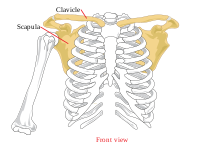
Photo from wikipedia
The sonographic appearance of soft tissue can be altered with movement. This can be related to both position change as well as torsional stress. The objective of this article is… Click to show full abstract
The sonographic appearance of soft tissue can be altered with movement. This can be related to both position change as well as torsional stress. The objective of this article is to demonstrate sonographic anatomy of the anterior shoulder as it moves into full external rotation. METHODS Ultrasound images were obtained in a healthy human subject. Conventional imaging locations were selected that are typically utilized to assess musculoskeletal and peripheral nerve anatomy as well as perform therapeutic injections. The transducer was centered over each region to obtain both short- and long-axis views. A pair of sonographic images was recorded for both imaging planes at each site: the first in anatomic neutral and second in full external rotation. In addition, a video recording was made at each site to track the movement of the muscles and nerves during external rotation. RESULTS The rotator interval including the intertubercular groove and biceps brachii long head moves far laterally when viewed in short axis, and it becomes out of plane when viewed in long axis. The subscapularis is relatively poorly visualized with the shoulder in neutral position, but the tendon and more distal aspect of the muscle are well visualized in full external rotation. The pectoralis major tendon insertion is well visualized in long axis with the shoulder in both neutral position and full external rotation. Movement of the humerus and the pectoralis major insertion are seen with shoulder rotation. The muscle appears to tighten and lengthen. The pectoralis major muscle is also seen in greater detail in external rotation. The cord level of the brachial plexus is also visualized at the infraclavicular portion of the anterior shoulder. The medial, posterior, and lateral cords are visualized in relation to the axillary artery. The relative position of the cords is only minimally altered with external rotation; however, the overlying pectoralis minor is tightened, and its influence can be visualized. DISCUSSION External rotation has a considerable effect on the sonographic appearance of the anterior shoulder. Targets used for therapeutic injections, such as the bicipital groove, rotate out of clear view. Some chemodenervation targets, such as the muscle of the subscapularis, can only be accessed with the shoulder in full external rotation. Full external rotation of the shoulder also places torsional stress on some of the anterior shoulder structures, such as the pectorals, which can provide diagnostic clues in certain pathologic conditions. CONCLUSION Movement into external rotation changes the sonographic appearance of the anatomic relationships of the anterior shoulder. Knowledge of these torsional changes can have both diagnostic and therapeutic implications.
Journal Title: Journal of computer assisted tomography
Year Published: 2019
Link to full text (if available)
Share on Social Media: Sign Up to like & get
recommendations!